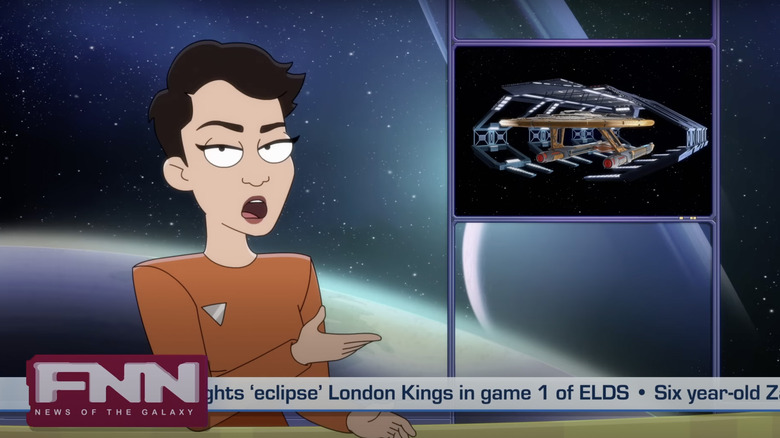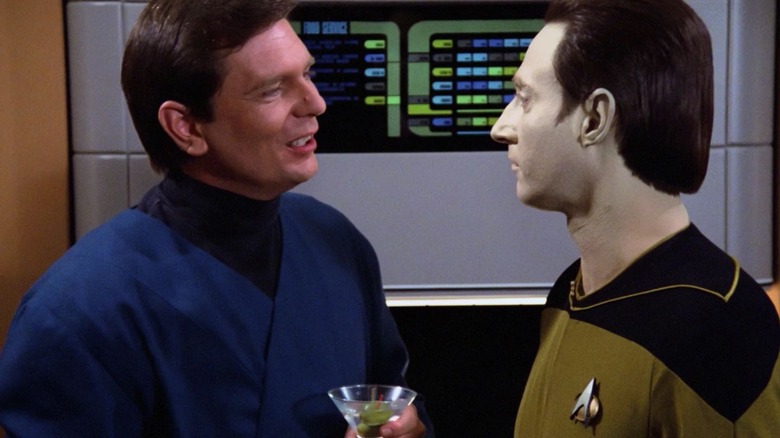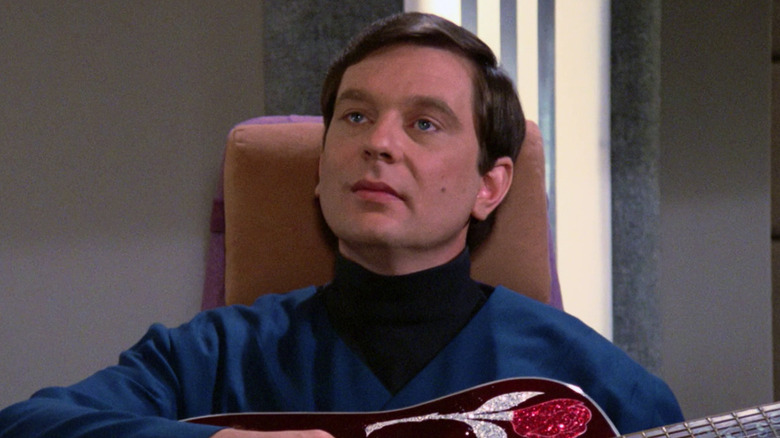One Of Star Trek: Lower Decks Season 3's Geekiest Jokes Hides In Plain Sight
While "Star Trek: Lower Decks" is a delightful workplace comedy in its own right, Trekkies have been having a ball combing through every episode looking for cute references to classic "Star Trek" episodes. In the first season episode "Veritas," the characters visited a museum of alien artifacts that featured a 50-foot humanoid skeleton that appeared to be wearing a tattered blue Starfleet uniform. This, for the well-trained eye, was a reference to the "Star Trek: The Animated Series" episode "The Infinite Vulcan" (originally aired October 20, 1973, and written by Walter Koenig!) wherein a species of intelligent plant people cloned a giant version of Spock to be their leader. At some point, that giant clone died and, by the 24th century events of "Lower Decks," ended up in an alien archive lightyears away. For the uninitiated, that skeleton was a spooky background detail. For Trekkies, it was everything.
The new season of "Lower Decks" premiered today, and it comes barreling out of the gate with a deluge of subtle jokes and references that even quick-eyed Trekkies may miss. The season's first episode, "Grounded," recaps the action of the show's second season via an old-fashioned news broadcast (it certainly is curious that televisions in the 24th century will still be available in 2022's standard 16:9 aspect ratio), complete with a bottom-of-the-screen chyron recapping the news of the day.
Among those stories are reports of a strategema championship (strategema was the holographic strategy game mastered by Sirna Kolrami, the expert tactician, in the "Star Trek: The Next Generation" episode "Peak Performance"), as well a story about a riot at a Sonny Clemonds concert.
If Sonny Clemonds sounds familiar, it's because you remember the last episode of the first season of "Star Trek: The Next Generation."
The Neutral Zone
The first season of "Star Trek: The Next Generation" wasn't the show's most auspicious time. While it did effectively establish a new ship, a new timeframe, and a new ensemble of fascinating characters, the scripts were frequently lacking (the hour-long 2014 documentary "Chaos on the Bridge" details the conflicts and the constant re-writes that the show suffered throughout its first two seasons). The final episode of the first season was called "The Neutral Zone" (May 16, 1988), and it's most notable for re-introducing the Romulans back into "Trek." The "A" plot involved the Enterprise investigating a potential Romulan threat, but the bulk of the episode was taken up by a "B" plot wherein a trio of late-20th century people were found in a floating space pod and unfrozen.
The three unfrozen modern-day people were included — and this has creator Gene Roddenberry's fingerprints all over it — primarily to be preached to. Captain Picard (Patrick Stewart) was permitted to explain to them (and, by extension, audiences) that humanity became enlightened in the last four centuries, and that wealth is no longer a motivating factor in our lives. Ancient diseases have all been eliminated (indeed, the three modern people in question had themselves frozen in order to awaken at a time when their slow-moving diseases could be cured), and, golly, we're just so much better off in "Star Trek" than you poor saps in 1988 are.
The three characters were Claire Raymond (Gracie Harrison), Ralph Offenhouse (Peter Mark Richmond), and L.Q. "Sonny" Clemonds (Leon Rippy) a once-aspiring country singer.
Of the three, Clemonds adapts to life in the 24th century the best. Once he learns that he can synthesize martinis out of thin air and replicate guitars, he's pretty much set.
L.Q. Sonny Clemonds
Sonny Clemonds also flirts with Dr. Crusher and makes mention of the fact that he might still have a music career ahead of him. While Claire frets about losing her whole family (she has to look up her descendants to gain comfort), and Ralph is frustrated that his career as a cutthroat investor has been stymied by a new economic philosophy, Sonny has no regrets. Indeed, in a rather pragmatic fashion, Sonny posits that his old fashioned type of music may be welcomed in the distant future and elects to remain optimistic. One can only imagine what a 400-year-old musician may have to offer the modern world. I, for one, would definitely pay top dollar to see what, say, Giacomo Finetti, one of the hottest musicians of 1622, was up to.
The chyron gag at the head of "Grounded" implies that Clemonds not only pursued a music career, but that he had become incredibly popular. So popular, in fact, that his music inspired riots and tramplings. The down-home country twang of the late 20th century — emitted from a specialized, glittery, rose-encrusted guitar — are enough to cause a sensation in the late 24th century of "Lower Decks."
There is no word as to what Claire Raymond and Ralph Offenhouse are up to, but perhaps we can assume they, too, are doing well. Claire became a genealogist, and Ralph presumably moved to Ferenginar where he could continue his cutthroat business practices. "Star Trek" provides, even for its most beleaguered orphans.


